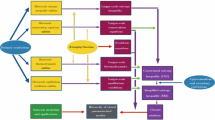Abstract
In the method of volume averaging, the difference between ordered and disordered porous media appears at two distinct points in the analysis, i.e. in the process of spatial smoothing and in the closure problem. In theclosure problem, the use of spatially periodic boundary conditions isconsistent with ordered porous media and the fields under consideration when the length-scale constraint,r 0≪L is satisfied. For disordered porous media, spatially periodic boundary conditions are an approximation in need of further study.
In theprocess of spatial smoothing, average quantities must be removed from area and volume integrals in order to extractlocal transport equations fromnonlocal equations. This leads to a series of geometrical integrals that need to be evaluated. In Part II we indicated that these integrals were constants for ordered porous media provided that the weighting function used in the averaging process contained thecellular average. We also indicated that these integrals were constrained by certain order of magnitude estimates for disordered porous media. In this paper we verify these characteristics of the geometrical integrals, and we examine their values for pseudo-periodic and uniformly random systems through the use of computer generated porous media.
Similar content being viewed by others
Abbreviations
- A βσ :
-
interfacial area of theβ-σ interface associated with the local closure problem, m2
- A βe :
-
area of entrances and exits for theβ-phase contained within the averaging system, m2
- a i :
-
i=1, 2, 3 gaussian probability distribution used to locate the position of particles
- I :
-
unit tensor
- L :
-
general characteristic length for volume averaged quantities, m
- L ε :
-
characteristic length forε β , m
- L ψ :
-
characteristic length for 〈ψ β 〉β, m
- ℓ σ :
-
characteristic length for theσ -phase particles, m
- ℓ 0 σ :
-
reference characteristic length for theσ-phase particles, m
- ℓ β :
-
characteristic length for theβ-phase, m
- ℓ i :
-
i=1, 2, 3 lattice vectors, m
- m :
-
convolution product weighting function
- m v :
-
special convolution product weighting function associated with the traditional volume average
- n i :
-
i=1, 2, 3 integers used to locate the position of particles
- n βσ :
-
unit normal vector pointing from theβ-phase toward theσ-phase
- n βe :
-
outwardly directed unit normal vector at the entrances and exits of theβ-phase
- r p :
-
position vector locating the centroid of a particle, m
- r σ :
-
gaussian probability distribution used to determine the size of a particle, m
- r 0 :
-
characteristic length of an averaging region, m
- r :
-
position vector, m
- r m :
-
support of the weighting functionm, m
- Υ :
-
averaging volume, m3
- V β :
-
volume of theβ-phase contained in the averaging volume,Υ, m3
- x :
-
positional vector locating the centroid of an averaging volume, m
- x 0 :
-
reference position vector associated with the centroid of an averaging volume, m
- y :
-
position vector locating points relative to the centroid, m
- y β :
-
position vector locating points in theβ-phase relative to the centroid, m
- γβ :
-
indicator function for theβ-phase
- δ βσ :
-
Dirac distribution associated with theβ-σ interface
- ε β :
-
V β /V, volume average porosity
- ε :
-
ℓ/L, small parameter in the method of spatial homogenization
- \(\sigma _{\alpha _i } \) :
-
standard deviation ofa i
- σ r :
-
standard deviation ofr σ
- 〈σ r 〉β :
-
intrinsic phase average ofψ β
References
Bear, J., 1972,Dynamics of Fluids in Porous Media, Elsevier, New York.
Bensoussan, A., Lions, J. L., and Papanicolaou, G., 1978,Asymptotic Analysis for Periodic Structures, North Holland, New York.
Brenner, H., 1980, A general theory of Taylor dispersion phenomena,Physico Chem. Hydrodyn. 1, 91–107.
Carbonell, R. G. and Whitaker, S., 1984, Heat and mass transport in porous media, in J. Bear and M. Y. Corapcioglu (eds.),Fundamentals of Transport Phenomena in Porous Media, Martinus Nijhoff, Dordrecht, pp. 121–198.
Chu, C. F. and Ng, K. M., 1989, Flow in packed tubes with a small tube to particle diameter ratio,A.I.Ch.E. Journal 35, 148–158.
Howes, F. A. and Whitaker, S., 1985, The spatial averaging theorem revisited,Chem. Engng. Sci. 41, 1387–1392.
Levy, T., 1983, Fluid flow through an array of fixed particles,Int. J. Engng. Sci. 21, 11–23.
Matheron, G., 1967,Eléments pour une théorie des milieux poreux, Masson et Cie., Editeurs, Paris.
Miš, J., 1987, On the existence of the derivative of the volume average,Transport in Porous Media 2, 615–621.
Prager, S., 1969, Improved variational bounds on some bulk properties of a two-phase random medium,J. Chem. Phys. 42, 701–719.
Prat, M., 1990, Modelling of heat transfer by conduction in a transition region between a porous medium and an external fluid,Transport in Porous Media 5, 71–95.
Prat, M., 1991, 2D modelling of drying of porous media: Influence of edge effects at the interface,Drying Tech. 9, 1181–1208.
Prat, M., 1992, Some refinements concerning the boundary conditions at the macroscopic level,Transport in Porous Media 7, 147–161.
Quintard, M. and Whitaker, S., 1990, Two-phase flow in heterogeneous porous media I: The influence of large spatial and temporal gradients,Transport in Porous Media 5, 341–379.
Rubinstein, J. and Torquato, S., 1989, Flow in random porous media: Mathematical formulation, variational principles, and rigorous bounds,J. Fluid Mech. 206, 25–46.
Salacuse, J. J. and Stell, G., 1982, Polydisperse systems: Statistical thermodynamics with applications to several models including hard and permeable spheres,J. Chem. Phys. 77, 3714.
Sanchez-Palencia, E., 1980, Non-homogeneous media and vibration theory,Lecture Notes in Physics 127, Springer-Verlag, New York.
Strieder, W. and Aris, R., 1973,Variational Methods Applied to Problems of Diffusion and Reaction, Springer-Verlag, New York.
Torquato, S., 1984, Bulk properties of two-phase disordered media: I. Cluster expansion for the effective dielectric constant of dispersion of penetrable spheres.J. Chem. Phys. 81, 5079.
Torquato, S., 1986, Microstructure characterization and bulk properties of disordered two-phase media,J. Stat. Physics 45, 843–873.
Veverka, V., 1981, Theorem for the local volume average of a gradient revisited,Chem. Engng. Sci. 36, 833–838.
Weissberg, H. L., 1963, Effective diffusion coefficients in porous media,J. Appl. Phys. 34, 2636–2644.
Zick, A. A. and Homsy, G. M., 1982, Stokes flow through periodic arrays of spheres,J. Fluid Mech. 115, 13–20.
Author information
Authors and Affiliations
Rights and permissions
About this article
Cite this article
Quintard, M., Whitaker, S. Transport in ordered and disordered porous media IV: Computer generated porous media for three-dimensional systems. Transp Porous Med 15, 51–70 (1994). https://doi.org/10.1007/BF01046158
Received:
Issue Date:
DOI: https://doi.org/10.1007/BF01046158




